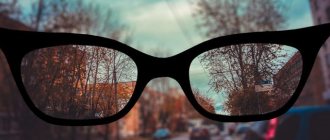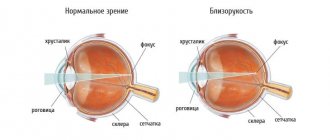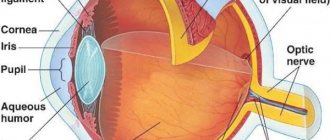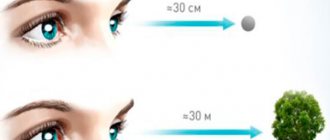Myopia, also known as myopia, is one of the most common vision pathologies along with hypermetropia and astigmatism. In this informational article we will talk about the features of the disease, how to choose the right glasses to correct myopia, and how to wear glasses correctly for myopia.
In this article
- Features of the pathology
- When and how to wear glasses for myopia?
- Are glasses for myopia a plus or a minus?
- What is better - lenses or glasses for myopia? Advantages and disadvantages
- What else do you need to know?
- How to choose glasses for myopia?
- Do I need to wear glasses all the time if I am nearsighted?
- Recommendations
Features of the pathology
According to experts, about forty percent of the population suffers from myopia, which is why the question of how to choose the right glasses for myopia is very relevant. Looking ahead, we will say that you can choose glasses only after consultation with an ophthalmologist, who will conduct an examination and be able to describe their parameters to you. So, what are the characteristics of myopia and why does it occur?
It has been established that in case of myopia, parallel rays after refraction are collected in front of the retina, that is, the main focus of the optical system does not coincide with the retina. Thus, it turns out that the eye is disproportionate, ametropic, since the length of the optical axis of the eye and the length of the focal length do not correspond to each other: either the refractive apparatus has a shorter focal length than the length of the eye (refractive myopia), or the length of the eye is longer than necessary for a given refractive power of the optical system (axial myopia).
In this regard, the following types of disease appear: mixed myopia (when the refractive error is caused by a deviation in both the axis length and the refractive power of the eye) and combination myopia. The latter depends on a peculiar combination of essentially normal elements of the optical ocular apparatus. At high degrees of myopia (above 6.0 diopters), axial myopia prevails, and at weak and moderate degrees, combinational myopia prevails. The following degrees of myopia are distinguished: first (up to 3 diopters), second (from 3 to 6 diopters) and third (more than 6 diopters).
Causes of myopia
Thanks to the development of science, today this visual impairment is well studied. In ophthalmology, the disease is called myopia.
In this article
- Causes of myopia
- Imaginary myopia
- How do people with varying degrees of myopia see?
- Treatment of myopia
- Prevention of myopia
At the physiological level, the pathology is associated with a defect in the shape of the eye lens. Under the influence of a number of factors, it changes and becomes more elongated. As a result, the optical axis of the eye increases, as a result, the refraction of light rays occurs at the wrong angle. The image is ultimately formed not on the retina, as with healthy vision, but in front of it.
Myopia happens:
- congenital;
- acquired.
In the first case, the disease is detected in a child in the first year of life. Experts believe the cause of its appearance is a genetic predisposition. If mom or dad had vision problems, then with a probability of up to 50% they will be passed on to the child. If the disorder was diagnosed in both parents, then with a risk of up to 75% the disease will be passed on to the baby.
In addition, the cause of congenital myopia during pregnancy can be:
- disorders during intrauterine development;
- bad habits;
- poor nutrition;
- infectious diseases;
- fetal hypoxia;
- premature or difficult birth.
Factors contributing to the development of myopia during life are:
- prolonged eye strain;
- violation of work and rest schedules;
- poor lighting when working with small parts or reading for a long time;
- long periods of work at the computer without a break.
Very often, myopia appears in schoolchildren when visual stress increases. During this period, it is very important to pay attention to the problem, since without proper treatment the disease will progress.
When and how to wear glasses for myopia?
In the modern world, there are several options with which you can correct the existing disease. Perhaps the most innovative is wearing contact lenses. Today, manufacturers make them from soft hydrogel materials that are absolutely safe, allow oxygen to pass through and contain the optimal amount of moisture. But there are those people who still cannot feel comfortable when using lenses. Another method of correction is surgery. However, it is worth considering that in some cases it has only a temporary effect. There are also restrictions on age and the presence of other diseases. From all of the above, we can conclude that the safest correction method, although not the most comfortable from an aesthetic point of view, is the use of glasses.
Doctors also tend to believe that glasses are a safer and more affordable method than any other. Special glasses for myopia are equipped with concave lenses with a scattering effect. They refract light rays so that the focus of a particular object is directly on the surface of the retina. This characteristic allows you to see the object more clearly with well-defined contours.
Visual acuity 2.0. What does it mean?
It is difficult to overestimate the importance that vision has for a person. With the help of vision, a person receives the lion's share of information about the world around him.
If you ask any person whether he would like to have acute, or even better, super-acute vision, then, I think, no one would answer in the negative. Good vision means a good quality of life.
But what do the words “visual acuity” mean and how is this acuity calculated?
Visual acuity is defined as the ability to see two small dots that are the shortest distance apart as two separate objects, rather than as one fused object. It is the ability to identify even smaller details in a small object located at a great distance that is called visual acuity.
There is such a simple concept in optics as angle of view. This is the angle that is obtained between the extreme points of the object that is being viewed (for example, the top and bottom of a letter), and the central point of the eye.
The smallest possible angle of view at which the human eye is still able to perceive two points separately from each other, and not together, determines the visual acuity of the eye. It is clear that the smaller this angle, the sharper the vision.
This definition of visual acuity first appeared about three hundred years ago. The English natural scientist Robert Hooke, looking at the starry sky through a telescope once again, concluded that the minimum distance between the stars at which the eye is still able to perceive two stars as separate objects is approximately one minute of arc.
Based on this conclusion, 100 years later, the first table for calculating visual acuity was created - the table of Dr. Snellen, a famous German ophthalmologist. Snellen accepted a visual angle of one degree as the physiological norm corresponding to one hundred percent vision.
In Russia, it is customary to use the Sivtsev table to calculate visual acuity. Everyone probably remembers it - Sh, B, below - m, n, k...
If you look at the tenth line of the table, corresponding to normal 100% vision, from the required distance of exactly 5 meters, then the angle between the top point of the letter, the central point of the eye and the bottom point of the letter will be equal to one degree.
All lines in the table are numbered in accordance with visual acuity from 0.1 to 2. For example, if a person can see from a distance of exactly 5 meters not the tenth line, but only the fifth, this means that his visual acuity is 0.5, and the smallest possible angle of view in this In this case, not 1 degree, as in a normal eye, but 2 degrees.
But one hundred percent vision, in other words 1, is far from the limit, it is the lower limit of the norm. There are people who have vision of 1.5 (150%), 2 (200%) and even more. The sharpest vision ever recorded is 6, or 600%.
If a person sees line 11 of the test table well (those lines that are already below the line), then he has 150 percent vision, if he sees line 12, he has 2 vision, that is, 200%.
But what does this depend on? I mean, why are some people so lucky?
The limit of the ability to distinguish the smallest details is limited by the structure of the retina. Some people have a naturally higher retinal resolution.
Cases have also been described of how people achieved ultra-high visual acuity by training in looking out for distant objects. Basically, these are hunters, snipers, and, of course, Indians, whose supernatural vision was legendary.
In conclusion, I would like to give a simple recipe on how to maintain and improve visual acuity: to do this, you need to look at distant objects with interest more often. Look at them, pay attention to details, colors, shapes. Count distant objects and compare them with each other. Turn it into entertainment, into a pleasant game. But this must be done without undue effort. The main thing is not to stress. If something is impossible to see, just immediately switch your attention to another distant object.
And his vision will become sharper, and what else remains for him, remember the experience of hunters and Indians.
Are glasses for myopia a plus or a minus?
Many people still wonder what lenses are available with glasses to correct myopia. The answer is obvious: with a minus. Let's decipher why. The fact is that in a person suffering from myopia, the focus of the image is in front of the retina, and not exactly on it, so objects at long distances are poorly visible. To eliminate the pathology, you need to shift the focus to the retina. This process is carried out using a concave lens with a “minus” sign (for farsightedness glasses there is a “+” sign).
Normal child vision
Children see thanks to the coordinated work of various structures. The clarity of the resulting image is determined by the state of the optical system and the brain. The child's eye is able to perceive electromagnetic radiation and transform it into an image on the retina. The eyes are formed by the apples, nerves and auxiliary apparatus.
About 220 million children suffer from visual impairment, and in 8% of cases the problem cannot be eliminated. Children with a persistent decrease in the visual acuity of objects need special care.
Not everyone knows how to improve a child’s vision. For myopia, treatment is determined by its degree. If myopia progresses by less than 0.5 diopters per year, monitoring the child is sufficient. In more severe cases, treatment is carried out. The main aspects of therapy are:
- correction with glasses or contact lenses;
- visual gymnastics;
- neck and head massage;
- physiotherapy;
- taking vitamins;
- use of vasodilators;
- scleroplasty.
Laser vision correction for children is only possible when they reach 18 years of age. Its advantage is that it is very effective and affordable.
If a child’s vision decreases due to astigmatism, every ophthalmologist knows what to do in this situation. Until the age of 18, conservative therapy is carried out. It includes the use of cylindrical, contact or spherocylindrical lenses.
The choice depends on the age of the patient. It is recommended to wear hard contact lenses at night. For astigmatism less than 1.5 diopters, orthokeratotherapy is performed. After children with visual impairment have been diagnosed, the doctor determines the timing of the operation. The table allows you to estimate the degree of astigmatism.
Surgical intervention is indicated from 18–20 years of age. Laser therapy or keratotomy is performed.
Not everyone knows how to restore vision to a child if he has amblyopia. In this case, treatment is effective up to 10–12 years. Once children with visual impairment are diagnosed, the underlying cause of amblyopia is eliminated. Ptosis correction, vitrectomy, cataract treatment and strabismus correction can be performed.
Surprisingly, up to six months, a child’s vision is 20-25 times weaker than that of an adult. He is able to see only large objects located at a distance.
From one and a half to 3 years of age, the normal vision for children is 0.6-0.8. Now he can focus his gaze on any object.
From 3 to 5 years, children’s vision is already approaching that of an adult and is 0.8-0.9. But at this age, due to insufficiently developed muscles, hereditary myopia may appear.
At 5 - 7 years old, a child sees almost the same as an adult, the norm is 0.9 - 1. During this period, he is quite ready for reading and writing. But vision continues to develop until the end of eye growth - up to 12 years.
To prevent vision problems in a child, it is necessary to act comprehensively. A healthy lifestyle and regular examinations with an ophthalmologist are already a big step towards maintaining eye health.
Replace your child's many hours of sitting in front of the TV and computer with outdoor games or other physical activity.
What is better - lenses or glasses for myopia? Advantages and disadvantages
We partially answered this question above, but it’s worth stopping and talking in more detail about the advantages and disadvantages of using glasses and contact lenses. Ophthalmologists say that a person with slight myopia can use both glasses and contacts only in certain cases. For example, for going to the cinema. If there is a third degree of the disease, then it is best to resort to contact lenses, since glasses are not able to provide one hundred percent vision. The above information is of a general nature, so only an ophthalmologist can answer the question of which correction method is best to choose (glasses or lenses). He will not only check your vision, but will also take into account your lifestyle, habits and characteristics of the body as a whole. It would not be amiss to say that glasses are considered the most affordable in terms of financial costs. In addition, one of the advantages is that constantly wearing them for myopia will not cause any complications. But there are also several significant disadvantages:
- changes in the field of visibility of the image are possible;
- often cannot guarantee 100% visual acuity, just like lenses;
- People often feel discomfort when choosing glasses.
What is myopia: “plus” or “minus”?
0
Myopia (myopia) is a serious problem that is associated not only with worsening vision, but also with an increased risk of complications. Myopic people find it difficult to perform many activities: driving a car, reading signs, information boards, and with a high degree of myopia, it is not easy to even see a familiar face at a distance of one or two meters.
According to the World Health Organization, up to 30% of the world's population suffers from this problem. The number of patients suffering from this myopia is steadily growing. Very often the disorder occurs in schoolchildren and students. People with good vision sometimes do not understand what myopia is: “plus” or “minus”? Let's look into this problem together.
What it is?
Myopia is a visual impairment in which a person has difficulty seeing objects located far away, but can clearly see objects that are very close. Nearsightedness is also called myopia.
One of the main components of the eye is the cornea and lens. They are able to transmit and refract rays of light. An image appears on the retina of the eye, which is transmitted through the optic nerve to the brain using nerve impulses.
If the cornea and lens refract the rays so that the focus is on the retina, then the image will be clear and vision will be one hundred percent.
With myopia, the image is blurry and unclear due to two abnormal factors:
- The eye is greatly elongated, and the retina moves away from the stable focus location. In people with myopia, the eye reaches 30 millimeters. And in a normal healthy person, the size of the eye is 23-24 mm.
- The lens and cornea refract light rays too much.
People with myopia have difficulty seeing objects that are far from them. But a myopic person sees objects close to the eyes well.
Causes
Myopia most often develops during school years. Heredity plays an important role in the development of pathology. It is important to consider whether one or both parents suffer from this disease. If both the father and mother have a disorder, then in 50% of cases it will also occur in the child before he or she comes of age. If the parents are healthy, then the risk of developing the disease is significantly reduced and is 8%.
Among the main factors contributing to the development of myopia are prolonged work at close distances under poor hygienic conditions or improper lighting. This reason is especially relevant today due to the widespread use of computers.
Distortion of the lens and reflection of objects
The development of myopia also contributes to weakening of the eye muscles. To solve this problem, special sets of physical exercises have been developed that can be used for both therapeutic and preventive purposes. Therapeutic eye exercises slow down the progression of myopia. Previously, ophthalmologists often recommended that myopic patients limit their physical activity. However, today the opinion of ophthalmologists has changed: moderate loads with a rational rest and sleep regime are recommended.
At a young age, myopia can be caused by:
- spasm of accommodation;
- keratoconus (change in the shape of the cornea);
- displacement of the lens due to injury (dislocation, subluxation);
- sclerosis of the lens.
The latter pathology leads to the development of myopia in old age.
There are other reasons that lead to the development of myopia:
- Lack of nutrients, vitamins, and minerals in the body. Vitamins B and C, as well as microelements such as magnesium, zinc, copper, and manganese, affect vision to a greater extent. All of them are necessary for the proper development and formation of the tissues of the sclera of the eye.
- Any eye strain caused by prolonged and continuous visual work.
- Lack of competent correction when the first symptoms of myopia appear. If the first signs of the disease are ignored, myopia will progress and lead to significant deterioration of vision.
- Incorrectly selected glasses or contact lenses for vision correction in case of early myopia.
- Congenital pathology (for example, weakness of the eye muscles responsible for changing the curvature of the lens).
- Some vision diseases (strabismus, astigmatism, etc.).
- Increased intracranial and intraocular pressure.
- All conditions that cause weakening of the body and disrupt the supply of nutrients to the eye (some infectious diseases, disruptions in the hormonal system, birth and traumatic brain injuries).
Symptoms
The main symptoms of myopia are:
- Fuzzy vision of distant objects;
- “flies” before the eyes;
- frequent headaches;
- rapid eye fatigue;
- splitting of objects;
- impaired twilight vision (in the dark, nearsighted people have difficulty driving a car and have poor orientation on the street);
- errors in color determination.
Depending on the degree of myopia, the patient's vision can vary from slight blurriness in the distance to complete blurriness even a few meters away.
Patients with a high degree of myopia see well literally right from the nose, but the further point of clear vision lies just a few centimeters from the eye.
Myopia can be combined with other visual diseases, such as astigmatism. Signs of this complicated form of the disease are:
- bifurcation of objects;
- distortion of objects;
- curved lines (instead of straight lines).
"Plus" or "minus"?
After studying visual acuity, all patients with refractive error undergo a trial vision correction using lenses. There are two types of lenses: diverging, denoted in ophthalmology by the sign “–” (minus), and converging, denoted by the sign “+” (plus).
Focus of the diverging lens
To correct myopia, diverging (“negative”) lenses are used. Thus, when they talk about glasses or lenses for correcting myopia, they always mean “minus” and not “plus”. But to correct farsightedness, “positive” or converging lenses are used, so farsightedness is a “plus”. What do the numbers mean, for example -2, -3.75 or any others?
The numbers indicate the optical power of the lenses needed for a patient with myopia to clearly see line 10 in Sivtsev’s table. Lens power is expressed in diopters and can have a fractional value. When writing out a prescription for glasses or contact lenses, each eye is given its own lens strength value.
There is such a thing as “false myopia,” which is not associated with changes in the eyes and is neither a “minus” nor a “plus.” This condition is caused by constant eye strain when working with nearby objects. False myopia can be treated with exercises and sometimes with medications, but does not require wearing glasses or contacts. In order not to confuse true myopia with false and not to purchase glasses in vain, it is necessary to immediately consult a doctor at the first signs of deterioration in vision.
The difference between a converging and diverging lens
A working method to restore vision! You will throw your glasses in the trash in just 3 days...
Restoring vision. Real life story.
Diagnostics
Only an ophthalmologist can identify the disease, determine the degree of myopia and choose the most appropriate treatment method for a given case.
Diagnosis of myopia requires the following studies:
- testing distance visual acuity without glasses;
- determination of refraction (refraction) of the eyes and the degree of myopia;
- choosing the right lenses;
- measuring eye length in an ultrasound room;
- measuring the thickness of the cornea at various points;
- examination of the fundus (will allow the doctor to assess the condition of the retina, blood vessels, optic nerve of each eye);
- selection of correction and treatment method.
Lack of myopia correction or incorrectly selected glasses (lenses) can lead to rapid deterioration of vision and the development of progressive myopia.
Treatment
Treatment of myopia is a complex process that can only be dealt with with the help of an ophthalmologist.
Modern methods of improving vision are varied:
Vision correction with glasses
- Laser correction.
- Optical correction of myopia.
- Methods of surgical intervention. Used when the disease is highly developed. It is possible to replace the lens with an intraocular lens and install an actual lens.
- Drug treatment of the disease.
- Correction of nutrition to improve blood supply to the eye and the supply of nutrients to it.
Laser vision correction for myopia
This is the most modern, safe and effective way to improve vision and get rid of the problem of myopia. Laser correction will allow the patient to stop wearing glasses and contact lenses. The essence of the intervention is to change the shape of the cornea, thereby reducing its optical power. Using a laser, it is possible to create the effect of wearing glasses, as if located inside the eyes, as a result of which light rays, after refraction in the lens, are focused on its retina.
Laser vision correction for myopia
There are several laser correction methods:
- LASIK (creation of corneal parameters using a template);
- Super LASIK (creation of individual cornea parameters);
- PRK (used for thin corneas and low myopia).
Each method has its own characteristics and is used depending on the condition of the eyes and the financial capabilities of the person.
Spectacle correction
Glasses are traditionally used to correct the vision of a patient suffering from myopia. They are equipped with diverging lenses, which weaken the optical system of the eye and push the image onto the retina. If myopia is complicated by astigmatism, you will need to wear glasses with cylinders.
Contact correction
Today, contact correction is gaining increasing popularity among young people. Contact lenses have a number of advantages over glasses. When properly selected and used, they provide clearer vision than glasses. Good lenses allow you to fully restore visual acuity without distortions and aberrations, which the best glasses cannot provide.
Complications
If myopia is not treated in a timely manner or corrected correctly, it may progress. Complications may occur such as:
- formation of scleral staphylomas (protrusion);
- retinal dystrophy;
- hemorrhages on the retina and vitreous body;
- cataract;
- retinal disinsertion.
Cataract as a consequence of advanced myopia
Complications due to myopia can occur at any age. In addition, destructive processes on the retina sometimes develop after surgical treatment of myopia due to the altered shape of the eye, which cannot be corrected.
In case of myopia (especially high degree), it is necessary to undergo regular examinations by an ophthalmologist, which will allow you to monitor the condition of the retina and make it possible to detect tears, holes, and thinning in time.
Prevention
Any disease is easier to prevent than to treat. Prevention of myopia involves the following measures:
- Adjusting the lighting mode. Visual stress is allowed only in good lighting using overhead light, a table lamp 60-100 W. Do not work under fluorescent lamps.
- Compliance with the regime of visual and physical activity. It is recommended to alternate visual strain with active, active rest: with myopia up to 3 diopters, physical activity is not limited; over 3 diopters, lifting weights, jumping and some types of competitions are prohibited.
- Gymnastics for the eyes (every 20-30 minutes).
- Correct vision correction prescribed by an ophthalmologist.
- Training of muscles, the tension of which leads to the growth of myopia (laser stimulation, video-computer vision correction, eye drops, special courses of eye gymnastics).
- Ophthalmological diagnostics: ultrasound measurement of the longitudinal size of the eye (once every six months).
- General strengthening measures (swimming, massage of the collar area, contrast shower) on the recommendation of an ophthalmologist.
- Complete balanced nutrition.
The first signs of eye glaucoma.
Farsightedness is a plus or a minus: https://eyesdocs.ru/zabolevaniya/gipermetropiya/opredelenie-dalnozorkosti-xarakternye-simptomy.html
How long to wear contact lenses: everything about the types and rules of use is written in this article.
Video
conclusions
So, myopia (hypermetropia) is a disease that must be treated in time to prevent progression and many complications. For myopia, wear minus lenses prescribed by your doctor. Impaired refraction of vision can lead to complete loss of vision, so its prevention and proper correction of myopia are extremely important. Read in more detail what vision minus 1 is.
What else do you need to know?
To choose the right glasses for vision correction for myopia, you need to consider a few more points. There are special plus models recommended for myopia. Experts call this approach non-classical, since the glasses are equipped with lenses with smaller diopters. But the point is that this method allows you to relieve accommodative spasm, which contributes to the development of myopia. How is it possible to correct vision in this case? The fact is that improvement occurs due to an independent “fight” against the disease. Of course, this method is very specific and is not suitable for everyone, but you can still consult a doctor on this topic. If you are satisfied with this approach, then the ophthalmologist will tell you how to choose the right glasses of this type.
How to choose glasses for myopia?
So, how to choose the right glasses for myopia? First, you should make an appointment with a specialist, who should conduct a thorough examination. He will determine the exact degree of vision loss, evaluate binocular vision, tell you what glasses will be used to correct myopia, whether minus or plus lenses are needed for this, and, if necessary, prescribe medications that will help relieve eye strain.
We remind you that it is extremely important that all of the above procedures are performed by a highly qualified ophthalmologist, since illiterate wearing of glasses for myopia can have a lot of consequences. Plus, the wrong choice of products for vision correction quite often negatively affects the success of treatment. After examination by a specialist, you can safely order glasses for myopia. The color and shape of the frame are selected taking into account individual preferences.
Do I need to wear glasses all the time if I am nearsighted?
A couple more questions that concern many people: is it worth wearing glasses for myopia all the time or can you take breaks? What glasses should be worn for high and other degrees? Ophthalmologists say the following: if the stage is not very high, glasses should be used regularly to prevent severe strain on the eye muscles and loss of vision. However, there may be exceptions, especially if we are talking about some type of work. For example, you can work without glasses at a distance of no more than 40 centimeters. With a high degree of myopia, it is necessary to regularly wear glasses, and special ones. At the same time, ophthalmologists recommend resorting to several types at once. For example, models for constant wear for myopia, if necessary, can be replaced with glasses for reading and writing.
Recommendations
What is also important to know in order to choose glasses for myopia? If you put on glasses and the picture before your eyes is unclear, this is the first sign that the optics are chosen incorrectly. Plus, it’s worth remembering the following points:
- eyes wearing glasses should not be strained and get tired quickly;
- You should not be overcome by nausea and dizziness.
If at least one of the above signs bothers you, and the situation does not change within a week, then you need to contact a specialist. Perhaps you were prescribed glasses with the wrong lenses or you have an individual intolerance. The problem may also be due to incorrect placement of the optics in the frame.
There are some more facts that are worth remembering in order to know how to properly wear glasses for myopia.
Remember that in the presence of astigmatism and myopia, a special type of myopia glasses with cylindrical lenses is prescribed. It will also be difficult to correct anisometropia with glasses, that is, an anomaly in which the eyes have different optical powers. Lazy eye syndrome may begin to develop, and correcting the problem with glasses will be much more difficult. You will have to prescribe another type of treatment.
Lazy eye also develops in young preschool children with incomplete correction of a high degree of myopia. Low vision cannot be restored, and the success of treatment can only be guaranteed by prompt and complete vision correction. Summarizing all of the above, we draw a conclusion. Myopia is a problem for many people of different age groups. But modern medicine makes it possible to diagnose this disease in a timely manner almost always (including at an early stage) and correct the disease.
Despite the fact that many people currently prefer lenses, glasses for myopia still remain in high demand. They are prescribed to preschool children and adolescents, and adults also wear them. Do not delay your visit if you feel discomfort, do not risk your vision and the health of your body as a whole.











